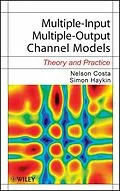A complete discussion of MIMO communications, from theory to
real-world applications
The emerging wireless technology Wideband Multiple-Input,
Multiple-Output (MIMO) holds the promise of greater bandwidth
efficiency and wireless link reliability. This technology is just
now being implemented into hardware and working its way into
wireless standards such as the ubiquitous 802.11g, as well as
third- and fourth-generation cellular standards.
Multiple-Input Multiple-Output Channel Models uniquely brings
together the theoretical and practical aspects of MIMO
communications, revealing how these systems use their multipath
diversity to increase channel capacity. It gives the reader a clear
understanding of the underlying propagation mechanisms in the
wideband MIMO channel, which is fundamental to the development of
communication algorithms, signaling strategies, and transceiver
design for MIMO systems.
MIMO channel models are important tools in understanding the
potential gains of a MIMO system. This book discusses two types of
wideband MIMO models in detail: correlative channel
models--specifically the Kronecker, Weichselberger, and
structured models--and cluster models, including
Saleh-Valenzuela, European Cooperation in the field of Scientific
and Technical Research (COST) 273, and Random Cluster models. From
simple to complex, the reader will understand the models'
mechanisms and the reasons behind the parameters. Next, channel
sounding is explained in detail, presenting the theory behind a few
channel sounding techniques used to sound narrowband and wideband
channels. The technique of digital matched filtering is then
examined and, using real-life data, is shown to provide very
accurate estimates of channel gains. The book concludes with a
performance analysis of the structured and Kronecker models.
Multiple-Input Multiple-Output Channel Models is the first book
to apply tensor calculus to the problem of wideband MIMO channel
modeling. Each chapter features a list of important references,
including core literary references, Matlab implementations of key
models, and the location of databases that can be used to help in
the development of new models or communication algorithms.
Engineers who are working in the development of telecommunications
systems will find this resource invaluable, as will researchers and
students at the graduate or post-graduate level.
Autorentext
Nelson Costa, PhD, is President and CEO of Deus Ex Machina Consulting Inc.
Simon Haykin is Distinguished University Professor at McMaster University, Ontario, Canada.
Klappentext
A complete discussion of MIMO communications, from theory to real-world applications
The emerging wireless technology Wideband Multiple-Input, Multiple-Output (MIMO) holds the promise of greater bandwidth efficiency and wireless link reliability. This technology is just now being implemented into hardware and working its way into wireless standards such as the ubiquitous 802.11g, as well as third- and fourth-generation cellular standards.
Multiple-Input Multiple-Output Channel Models uniquely brings together the theoretical and practical aspects of MIMO communications, revealing how these systems use their multipath diversity to increase channel capacity. It gives the reader a clear understanding of the underlying propagation mechanisms in the wideband MIMO channel, which is fundamental to the development of communication algorithms, signaling strategies, and transceiver design for MIMO systems.
MIMO channel models are important tools in understanding the potential gains of a MIMO system. This book discusses two types of wideband MIMO models in detail: correlative channel models—specifically the Kronecker, Weichselberger, and structured models—and cluster models, including Saleh-Valenzuela, European Cooperation in the field of Scientific and Technical Research (COST) 273, and Random Cluster models. From simple to complex, the reader will understand the models' mechanisms and the reasons behind the parameters. Next, channel sounding is explained in detail, presenting the theory behind a few channel sounding techniques used to sound narrowband and wideband channels. The technique of digital matched filtering is then examined and, using real-life data, is shown to provide very accurate estimates of channel gains. The book concludes with a performance analysis of the structured and Kronecker models.
Multiple-Input Multiple-Output Channel Models is the first book to apply tensor calculus to the problem of wideband MIMO channel modeling. Each chapter features a list of important references, including core literary references, Matlab implementations of key models, and the location of databases that can be used to help in the development of new models or communication algorithms. Engineers who are working in the development of telecommunications systems will find this resource invaluable, as will researchers and students at the graduate or post-graduate level.
Inhalt
Preface.
Chapter 1: Introduction.
1.1 Historical Perspective.
1.1.1 Electromagnetism.
1.1.2 The Hertz Transmitter.
1.1.3 Tesla and Wireless Power.
1.1.4 Lodge and Tunable Circuits.
1.1.5 Marconi and Trans-Atlantic Communication.
1.2 MIMO Communications.
1.3 MIMO Channel Models.
1.3.1 The Channel Model Spectrum.
1.3.2 Wideband MIMO Channel Models.
1.4 Software Defined Radio.
1.5 Overview.
1.5.1 Chapter 2: Multiple Antenna Channels and Correlation.
1.5.2 Chapter 3: Correlative Models.
1.5.3 Chapter 4: Cluster Models.
1.5.4 Chapter 5: Channel Sounding.
1.5.5 Chapter 6: Experimental Validation.
1.5.6 Appendices: Background and Definitions.
Chapter 2: Multiple Antenna Channels and Correlation.
2.1 The Radio Channel: Definitions.
2.1.1 The Physical Channel.
2.1.2 The Analytical Channel.
2.2 Channel Classifications.
2.2.1 Linear Time-Invariant Channels.
2.2.2 Time-Invariant Narrowband Channels.
2.2.3 Time-Varying Wideband Channels and Bello's Model.
2.2.4 The Tapped-Delay Line Model and the Physical Channel.
2.2.5 Narrowband Diversity Channels.
2.2.6 The Narrowband MIMO Channel.
2.2.7 The Wideband MIMO Channel.
2.2.8 The Wideband MIMO Channel Recast Using Tensors.
2.3 Summary of Channel Classifications.
2.4 Second-Order Statistics of Multiple Antenna Channels.
2.4.1 Second-Order Statistics of the Vector Channel.
2.4.2 Second-Order Statistics of the Narrowband MIMO Channel.
2.5 Second-order Statistics of the Wideband MIMO Channel.
2.5.1 Eigenvalue Decomposition of the Wideband Correlation Matrix.
2.6 Spatial Structure of Multiple Antenna Channels.
2.6.1 SIMO Channels and Beamformers.
2.6.2 MIMO Beamformers.
2.7 Summary and Discussion.
2.7.1 Channel Classifications.
2.7.2 Multi-Antenna Channels.
2.7.3 Spatial Structure and the APS.
2.8 Notes and References.
2.8.1 Channel Classifications.
2.8.2 Second-Order Statistics of Multi-Antenna Channels.
2.8.3 The Spatial Structure of Multi-Antenna Channels.
Chapter 3: Correlative Models.
3.1 Vector Channel Synthesis from the Vector Correlation Matrix.
3.2 Matrix Channel Synthesis from the Narrowband Correlation Matrix.
3.2.1 Number of Model Parameters.
3.3 One-Sided Correlation for Narrowband MIMO Channels.
3.4 The Kronecker Model.
3.4.1 The Narrowband Kronecker Model.
3.4.2 The Wideband Kronecker Model.
3.4.3 Notes on the Narrowband and Wideband Kronecke…
